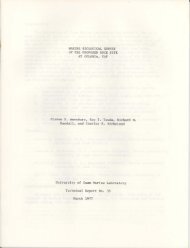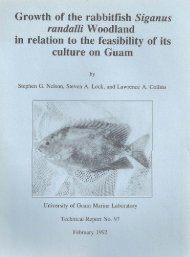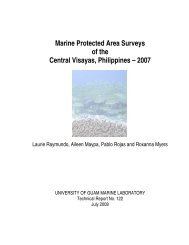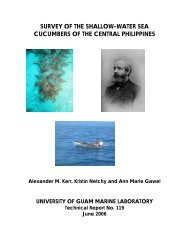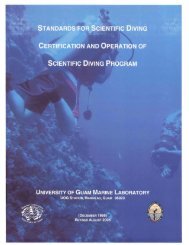Taxonomic inventories and assessments of terrestrial snails on the ...
Taxonomic inventories and assessments of terrestrial snails on the ...
Taxonomic inventories and assessments of terrestrial snails on the ...
Create successful ePaper yourself
Turn your PDF publications into a flip-book with our unique Google optimized e-Paper software.
shells <str<strong>on</strong>g>of</str<strong>on</strong>g> assimineids, succineids, helicari<strong>on</strong>ids, subulinids, <str<strong>on</strong>g>and</str<strong>on</strong>g> G<strong>on</strong>axis kibweziensis. In<br />
sampling leaf litter <str<strong>on</strong>g>and</str<strong>on</strong>g> surface rocks in Aguiguan, Smith (1995) discovered yet ano<strong>the</strong>r snail<br />
predator in 1992, <strong>the</strong> triclad turbellarian Platydemus manokwari. As many as eight large<br />
flatworms were found beneath individual surface rocks measuring 23 × 15 cm (Smith,<br />
unpublished 1992 data). Because many <str<strong>on</strong>g>of</str<strong>on</strong>g> <strong>the</strong> ground shells <str<strong>on</strong>g>of</str<strong>on</strong>g> Partula gibba <str<strong>on</strong>g>and</str<strong>on</strong>g> Partula<br />
langfordi were still relatively lustrous in appearance, it was c<strong>on</strong>cluded that <strong>the</strong> mortalities<br />
occurred within <strong>the</strong> previous year. This flatworm was apparently introduced to Aguiguan from<br />
Tinian in potted plants as part <str<strong>on</strong>g>of</str<strong>on</strong>g> a reforestati<strong>on</strong> project in1991 (C. Rice, pers<strong>on</strong>al<br />
communicati<strong>on</strong>, November 1992). Platydemus manokwari was previously reported to be<br />
established in Tinian by 1984 (Eldredge, 1988; Eldredge <str<strong>on</strong>g>and</str<strong>on</strong>g> Smith, 1994).<br />
As a c<strong>on</strong>sequence <str<strong>on</strong>g>of</str<strong>on</strong>g> <strong>the</strong> decline <str<strong>on</strong>g>of</str<strong>on</strong>g> <strong>the</strong> tree <str<strong>on</strong>g>snails</str<strong>on</strong>g> <str<strong>on</strong>g>and</str<strong>on</strong>g> <strong>the</strong> introducti<strong>on</strong> <str<strong>on</strong>g>of</str<strong>on</strong>g> Platydemus<br />
manokwari in Aguiguan, Partula gibba <str<strong>on</strong>g>and</str<strong>on</strong>g> Partula langfordi were proposed for listing as<br />
C<str<strong>on</strong>g>and</str<strong>on</strong>g>idate Species for protecti<strong>on</strong> under <strong>the</strong> U.S. Endangered Species Act (16 U.S.C. 1531 et<br />
seq.) in 1994 (Federal Register, 1994). In 1996, <strong>the</strong>se <str<strong>on</strong>g>and</str<strong>on</strong>g> two additi<strong>on</strong>al species <str<strong>on</strong>g>of</str<strong>on</strong>g> partulid tree<br />
<str<strong>on</strong>g>snails</str<strong>on</strong>g> from <strong>the</strong> Mariana Isl<str<strong>on</strong>g>and</str<strong>on</strong>g>s were listed as C<str<strong>on</strong>g>and</str<strong>on</strong>g>idate Species. Tragically, <strong>the</strong> listing did not<br />
result in immediate efforts to c<strong>on</strong>serve <strong>the</strong> <str<strong>on</strong>g>snails</str<strong>on</strong>g>, <str<strong>on</strong>g>and</str<strong>on</strong>g> Partula langfordi, endemic to Aguiguan,<br />
may be extinct now. Partula gibba survives in Guam, Rota, Saipan, Sarigan, <str<strong>on</strong>g>and</str<strong>on</strong>g> Pagan; <strong>the</strong><br />
status <str<strong>on</strong>g>of</str<strong>on</strong>g> this species in Anatahan <str<strong>on</strong>g>and</str<strong>on</strong>g> Alamagan is presently unknown.<br />
The present study indicates that <strong>the</strong> ground-dwelling <str<strong>on</strong>g>snails</str<strong>on</strong>g> <str<strong>on</strong>g>of</str<strong>on</strong>g> Tinian <str<strong>on</strong>g>and</str<strong>on</strong>g> Aguiguan have<br />
declined in a pattern similar to that <str<strong>on</strong>g>of</str<strong>on</strong>g> <strong>the</strong> tree <str<strong>on</strong>g>snails</str<strong>on</strong>g>. Synoptic collecti<strong>on</strong>s in <strong>the</strong> Bernice P.<br />
Bishop Museum c<strong>on</strong>tain some 19 indigenous species <str<strong>on</strong>g>of</str<strong>on</strong>g> l<str<strong>on</strong>g>and</str<strong>on</strong>g> <str<strong>on</strong>g>snails</str<strong>on</strong>g> (Smith, 2008b <str<strong>on</strong>g>and</str<strong>on</strong>g> Table 6)<br />
plus <strong>the</strong> introduced G<strong>on</strong>axis kibweziensis. Interestingly, Achatina fulica specimens were not<br />
am<strong>on</strong>g <strong>the</strong> species lots from Aguiguan. Four species <str<strong>on</strong>g>of</str<strong>on</strong>g> live ground-dwelling <str<strong>on</strong>g>snails</str<strong>on</strong>g> <str<strong>on</strong>g>and</str<strong>on</strong>g> <strong>on</strong>e live<br />
arboreal species were encountered in 8 m 2 sampled in this study, (see Tables 4 <str<strong>on</strong>g>and</str<strong>on</strong>g> 5). Because<br />
<strong>the</strong>se five species may be lumped under three <str<strong>on</strong>g>of</str<strong>on</strong>g> <strong>the</strong> genera in Table 6, <strong>the</strong> total l<str<strong>on</strong>g>and</str<strong>on</strong>g> snail fauna<br />
is now 22 species, when G<strong>on</strong>axis kibweziensis is included. Therefore, some 84% (16 <str<strong>on</strong>g>of</str<strong>on</strong>g> 19<br />
species) <str<strong>on</strong>g>of</str<strong>on</strong>g> <strong>the</strong> ground-dwelling snail fauna <str<strong>on</strong>g>of</str<strong>on</strong>g> Aguiguan is in precipitous decline or is extinct.<br />
When combined with <strong>the</strong> tree <str<strong>on</strong>g>snails</str<strong>on</strong>g>, <strong>the</strong> figure rises to 86% (19 <str<strong>on</strong>g>of</str<strong>on</strong>g> 22 species).<br />
No specimens from Tinian were located in <strong>the</strong> Bishop Museum collecti<strong>on</strong>s. The present<br />
study found at least 14 species <str<strong>on</strong>g>of</str<strong>on</strong>g> l<str<strong>on</strong>g>and</str<strong>on</strong>g> <str<strong>on</strong>g>snails</str<strong>on</strong>g> in Tinian, <str<strong>on</strong>g>of</str<strong>on</strong>g> which 11 are thought to be indigenous<br />
<str<strong>on</strong>g>and</str<strong>on</strong>g> three to be introduced. Five species <str<strong>on</strong>g>of</str<strong>on</strong>g> living native l<str<strong>on</strong>g>and</str<strong>on</strong>g><str<strong>on</strong>g>snails</str<strong>on</strong>g> were found, suggesting that<br />
<strong>the</strong> extincti<strong>on</strong> rate in Tinian is at least 55%; for all <str<strong>on</strong>g>snails</str<strong>on</strong>g>, <strong>the</strong> rate is at least 64%. Because this<br />
estimate is based up<strong>on</strong> dead shells, <strong>the</strong> figure could be much higher. No reliable estimati<strong>on</strong> <str<strong>on</strong>g>of</str<strong>on</strong>g><br />
how l<strong>on</strong>g dead shells persist in Tinian <str<strong>on</strong>g>and</str<strong>on</strong>g> Aguiguan is possible, because <strong>the</strong>re are few reports <strong>on</strong><br />
<strong>the</strong> rate <str<strong>on</strong>g>of</str<strong>on</strong>g> dissoluti<strong>on</strong> <str<strong>on</strong>g>of</str<strong>on</strong>g> <strong>the</strong> empty shells <str<strong>on</strong>g>of</str<strong>on</strong>g> small gastropod shells in leaf litter, <str<strong>on</strong>g>and</str<strong>on</strong>g> n<strong>on</strong>e from<br />
Pacific isl<str<strong>on</strong>g>and</str<strong>on</strong>g>s. Factors that c<strong>on</strong>tribute to dissoluti<strong>on</strong> <str<strong>on</strong>g>of</str<strong>on</strong>g> dead shells include rainfall, pH <str<strong>on</strong>g>of</str<strong>on</strong>g> soil<br />
<str<strong>on</strong>g>and</str<strong>on</strong>g> leaf litter, exposure to sunlight, <str<strong>on</strong>g>and</str<strong>on</strong>g> bioerosi<strong>on</strong> (Cadée, 1998, 1999; Barrientos, 2000;<br />
Pearce, 2008).<br />
26





